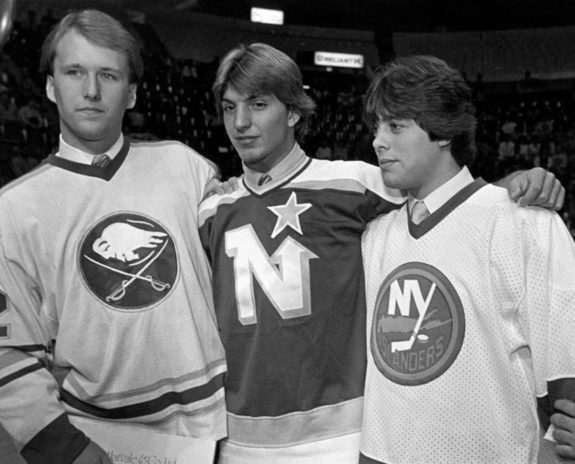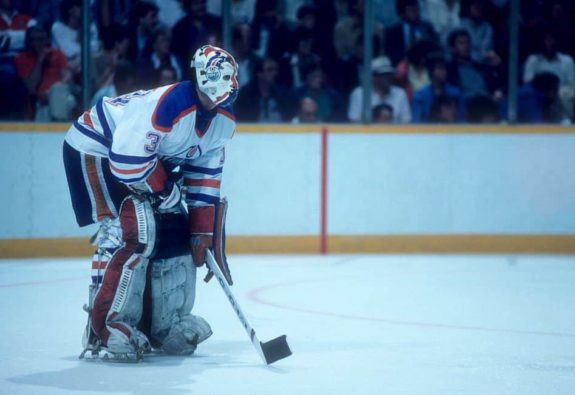Last week we looked at some of the best trades the Buffalo Sabres have made in their history, and while the list was impressive, it raises the question – what about the ones that didn’t go so well?
After all, every team has made bad trades in its history, it’s simply an inevitable part of sports. Unfortunately for the Sabres, they have even more examples in that category. Whether the deal aged poorly or looked troublesome from the outset, Buffalo has made some truly puzzling transactions throughout its 52-plus-year history. Keeping this list brief was difficult.
Let’s go back in Sabres history and review some of the trades that the team won’t be so quick to acknowledge making.
1988 – Darrin Shannon & Doug Bodger
In many ways, Tom Barrasso was the first superstar goaltender the Sabres had in their history. Drafted fifth overall in 1983 with a pick acquired from the Los Angeles Kings in exchange for Rick Martin, he opted to forgo his collegiate career and joined the Sabres as an 18-year-old high school graduate that fall. He immediately proved that it was the correct decision, winning the Calder and Vezina Trophies in 1984. He then became the Sabres’ backbone for the next five seasons.

In Nov. 1988, the Sabres traded Barrasso to the Pittsburgh Penguins in exchange for prospect Darrin Shannon and defenseman Doug Bodger. The issue here was the return, as though Bodger became an integral part of the team’s defense and turned in eight solid seasons, the centerpiece did not pan out. Expected to become a big offensive contributor to complement superstar Pierre Turgeon, Shannon appeared in only 55 games for the Sabres across four seasons, recording just 24 points. Ironically, his older brother Darryl also had a four-year stint in Buffalo but saw far more success, helping the Sabres reach the Stanley Cup Final in 1999.
Barrasso, on the other hand, proved to be the missing piece for the Penguins and, alongside Mario Lemieux and Jaromir Jagr, led Pittsburgh to back-to-back Stanley Cup championships in 1991 and 1992. He retired in 2003 as one of the winningest American goaltenders in NHL history and remains one of the best players not currently in the Hockey Hall of Fame. It’s safe to assume the Sabres would redo this one if they could.
1990 – Dale Hawerchuk
Interestingly, the Sabres have made a number of superstar-for-superstar trades in their history, and this one was one of the first. At the 1990 Draft, Buffalo sent its longtime defensive anchor, Phil Housley, to Winnipeg in exchange for Jets cornerstone Dale Hawerchuk. Make no mistake about it, the problem wasn’t Hawerchuk, who immediately became one of the Sabres’ top weapons alongside Pat LaFontaine and Alexander Mogilny and contributed 385 points across five seasons.
Related: Sabres’ Interest in Chychrun Could Be Risky
The problem for the Sabres was that, despite Hawercuk’s contributions, the trade still proved to be too much for too little. In addition to giving up Housley, they sent the highly underrated Scott Arniel to the Jets, too. The teams also swapped their 1990 first-round selections in the trade. Buffalo selected Brad May at 14th overall while Winnipeg took Keith Tkachuk at 19th.
It’s difficult to judge trades involving draft picks based upon whom those draft picks became, but that’s about as split of an outcome as one could get. May remains a beloved figure in Sabres history and produced arguably the team’s most memorable moment ever, but there’s simply no comparing him to Tkachuk.
1993 – Grant Fuhr
Three years later, the Sabres made another blockbuster swap of future Hall of Famers, this time with their most storied rival. In a trade that is baffling in hindsight, the Toronto Maple Leafs sent goaltender Grant Fuhr and a fifth-round pick to Buffalo in exchange for winger Dave Andreychuk, goaltender Daren Puppa and Buffalo’s 1993 first-round pick.

Buffalo gave up three huge pieces in this trade. The significance of a first-round pick goes without saying, but it’s the other two assets that really make this one stand out. Puppa stepped into the starting role in net for Buffalo after the trade of Barrasso and, to his credit, performed very well. Andreychuk, meanwhile, was drafted by the Sabres in 1982 and was arguably the team’s best player of that decade, renowned for his goal-scoring prowess.
Fuhr is one of the greatest goaltenders of all time and nobody can deny that, but by 1993 his heyday was behind him. He did have some success in Buffalo, but he was constantly battling injuries across his three seasons and never appeared in more than 32 games. Though his injury problems proved oddly beneficial in that they opened the door for another goaltender (we’ll get to him), this trade is tough to justify even with that in mind.
2009 – Dominic Moore
Former Sabres general manager (GM) Darcy Regier was notorious for making patty-cake deals at trade deadlines rather than seek a legitimate asset to improve the team. This was the worst example by far. The Sabres were dealt two tough blows in the second half of the 2008-09 season, losing top goal scorer Thomas Vanek and goaltender Ryan Miller to injury. The team needed to make a big deal (literally) at the deadline to stay in the hunt, but the move they made was the exact opposite. On March 4, they sent a second-round pick to the Maple Leafs in exchange for Dominic Moore, a bottom-six forward.
That’s right, with Buffalo’s top two stars on the shelf and its postseason aspirations hanging in the balance, the team went out and got a depth player. To the surprise of no one, Moore was barely noticeable in his 18 games with the Sabres and recorded just four points. Coupling it with the fact that they also traded Ales Kotalik, a reliable top-six forward, to make room for him and this was a disaster all around. The Sabres finished two points out of a playoff spot that year.
Dishonorable Mentions
- 2010 – Nathan Paetsch and a second-round pick to the Columbus Blue Jackets for Raffi Torres.
- 2014 – Ryan Miller and Steve Ott to the St. Louis Blues for Jaroslav Halak, William Carrier, Chris Stewart, and a first-round pick.
- 2018 – Ryan O’Reilly to the St. Louis Blues for Vladimir Sobotka, Patrik Berglund, Tage Thompson, and a first-round pick.
- 2019 – Brendan Guhle and a first-round pick to the Anaheim Ducks for Brandon Montour
2001 – A 2002 First Round Pick & Vyacheslav Kozlov
The summer of 2001 was the beginning of the toughest period in Sabres history. The team was experiencing the start of what became severe financial hardships and the revelation of a fraud and embezzlement scandal by owner John Rigas was on the horizon (from “John Rigas, cable television executive who went to federal prison for fraud, dies at 96”, The Washington Post, 9/30/2021).
As a result, the Sabres were forced to slash their payroll and many key players had to be let go. The first was captain Michael Peca, who sat out the entire 2000-01 season due to a contract dispute and was traded to the New York Islanders. The worst was yet to come, however, and June 30, 2001, became a date that no Sabres fan will ever forget.
The Dominik Hasek era in Sabres history came to a sad end when the megastar netminder was traded to the Detroit Red Wings. Hasek spent nine brilliant seasons in Buffalo and won the Vezina Trophy six times in that span, as well as the Hart Trophy twice. His departure was a true paradigm shift for a team whose hopes hinged on him for nearly a decade. To make the matter even worse for the beleaguered Sabres, their return in the trade was paltry.
In the last article, we discussed how acquiring Hasek from the Chicago Blackhawks for essentially no cost at all was the best trade the Sabres have ever made. But ironically enough, the Dominator’s exit from Buffalo was arguably the worst trade they’ve made. In exchange for possibly the greatest player they’ve ever had, the Sabres received one player (Slava Kozlov, who spent one injury-plagued season with the team) and a 2002 first-round pick. How Regier was content with such a meager return is anybody’s guess, but it wasn’t a good look for the Sabres at all.
It’s true that Hasek was 36 years old at the time and his age without question played into Detroit’s negotiations, but he was still the best goaltender in the league and the reigning Vezina winner. Perhaps Regier was more concerned with the Red Wings assuming the entirety of his $8 million salary, but it looks as if the Sabres definitely could have commanded more in return for such a marquee player. Hasek won the Stanley Cup in his season with Detroit, while the Sabres very nearly relocated before being rescued by a new owner in 2003.
Sabres Have Very Mixed Trade Track Record
It goes to show that, though the Sabres have made some great deals in their day, they have even more in the opposite regard. It’s evidence of both how poorly managed the team has been at times (Regier was GM for 16 years, which is astounding in hindsight) and how much bad management can prevent a team from succeeding.
Kevyn Adams just wrapped up his fifth season as the Sabres’ top executive, and to this point, most of the moves he’s made have worked out. But there are still points to be addressed and his work is cut out for him still. Conventional wisdom states that it’s good to look to the past for guidance, but in Adams’ case, that might not be the best idea.
